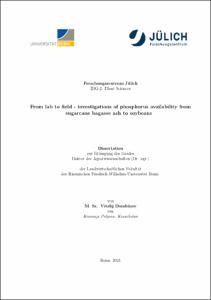From lab to field - investigations of phosphorus availability from sugarcane bagasse ash to soybeans

From lab to field - investigations of phosphorus availability from sugarcane bagasse ash to soybeans

| dc.contributor.advisor | Watt, Michelle | |
| dc.contributor.author | Dombinov, Vitalij | |
| dc.date.accessioned | 2021-05-26T15:00:04Z | |
| dc.date.available | 2021-05-26T15:00:04Z | |
| dc.date.issued | 26.05.2021 | |
| dc.identifier.uri | https://hdl.handle.net/20.500.11811/9109 | |
| dc.description.abstract | Every year the Brazilian sugarcane industry generates up to 10 million tons (dry matter) of ash from the combustion of sugarcane bagasse, which is a fibrous plant material that remains after sugarcane juice extraction. Bagasse ash is alkaline and contains minerals, including phosphorus (P) and potassium (K). Bagasse ash as a P-fertilizer has been poorly investigated. The experiments conducted and presented in this dissertation were aimed at investigating the fertilization effects of bagasse and bagasse-based ashes following a “From Lab to Field” approach. Soybean (Glycine max) was chosen as a model plant because of its suitability for greenhouse and field experiments, relevance for the Brazilian economy and use as rotation crop after sugarcane harvest. The aims of the present study were i) to investigate the efficiency of bagasse ash as a fertilizer for soybeans, ii) to identify factors integral to its fertilization success, and iii) to analyse the potential of bagasse ash as an additive to conventional and organic fertilizers under field conditions. In greenhouse pot experiments on nutrient-poor substrate, soybeans fertilized with bagasse ashes accumulated significantly less dry matter and took up less P and K than from triplesuperphosphate (TSP) and potassium sulphate. The fertilization effects of bagasse ashes were driven by the availability of P, a result supported by solubility analyses in various extraction solutions. The application of large dosages of ash produced comparable amounts of biomass as TSP-fertilized plants, but the uptake of P remained significantly lower than that from TSP. This is potentially related to suboptimal concentrations and ratios of minerals supplied by large dosages of ash. Co-combustion of bagasse with chicken manure, which is poor in Fe and Al but rich in alkali and alkaline earth metals, altered the physical and chemical composition of the ashes and their thermochemical products. The resulting increase in availability of P to soybeans appears to be due to the formation of Ca-alkali phosphates, as determined by X-ray diffraction analyses. Under greenhouse conditions in Oxisol soil, the P-fertilization effects of bagasse-based ash and its thermochemical products on soybean remained significantly lower than from TSP. This was probably due to fewer soluble P-forms in ash as compared to TSP, an increase in pH and suboptimal nutrient ratios and nutrient concentrations; all of which affected the ability of this fertilizer to meet the P demand for soybeans. Under field conditions (Goiânia, Brazil), co-fertilization of soybeans with bagasse ash and TSP (70% of P from bagasse ash) allowed a reduction in the P2O5 consumption from TSP by more than 50% and increased the grain yield by 11%. TSP-free fertilization of soybeans with 80 kg P2O5 in form of bagasse ash and cattle manure compost (50% of P from bagasse ash) increased the grain yield by 13%. Both increases are in comparison to control fertilization using TSP alone. Overall, fertilization effects of bagasse and bagasse-based ashes cannot compete with TSP. However, using bagasse ash as an additive to conventional and organic fertilizer has the potential to reduce the consumption of rock-P based fertilizer for soybeans in the field. | en |
| dc.language.iso | eng | |
| dc.rights | In Copyright | |
| dc.rights.uri | http://rightsstatements.org/vocab/InC/1.0/ | |
| dc.subject | Düngewirkungen | |
| dc.subject | Aschen | |
| dc.subject | Thermophosphate | |
| dc.subject | Substrat | |
| dc.subject | Oxisol-Boden | |
| dc.subject | Gewächshausversuche | |
| dc.subject | Feldversuche | |
| dc.subject | nicht-destruktive Messungen | |
| dc.subject | sequentielle Extraktion von Phosphor | |
| dc.subject | XRD | |
| dc.subject | NMR | |
| dc.subject | Fertiliser effects | |
| dc.subject | ashes | |
| dc.subject | thermophosphates | |
| dc.subject | substrate | |
| dc.subject | Oxisol soil | |
| dc.subject | greenhouse experiments | |
| dc.subject | field experiments | |
| dc.subject | non-invasive measurements | |
| dc.subject | sequential extraction of phosphorus | |
| dc.subject.ddc | 630 Landwirtschaft, Veterinärmedizin | |
| dc.title | From lab to field - investigations of phosphorus availability from sugarcane bagasse ash to soybeans | |
| dc.type | Dissertation oder Habilitation | |
| dc.publisher.name | Universitäts- und Landesbibliothek Bonn | |
| dc.publisher.location | Bonn | |
| dc.rights.accessRights | openAccess | |
| dc.identifier.urn | https://nbn-resolving.org/urn:nbn:de:hbz:5-62414 | |
| ulbbn.pubtype | Erstveröffentlichung | |
| ulbbnediss.affiliation.name | Rheinische Friedrich-Wilhelms-Universität Bonn | |
| ulbbnediss.affiliation.location | Bonn | |
| ulbbnediss.thesis.level | Dissertation | |
| ulbbnediss.dissID | 6241 | |
| ulbbnediss.date.accepted | 11.11.2020 | |
| ulbbnediss.institute | Landwirtschaftliche Fakultät : Institut für Nutzpflanzenwissenschaften und Ressourcenschutz (INRES) | |
| ulbbnediss.fakultaet | Landwirtschaftliche Fakultät | |
| dc.contributor.coReferee | Becker, Mathias | |
| ulbbnediss.contributor.orcid | https://orcid.org/0000-0003-0602-5762 | |
| ulbbnediss.contributor.gnd | 1235773787 |
Files in this item
This item appears in the following Collection(s)
-
E-Dissertationen (1004)




